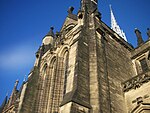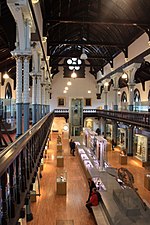Kelvingrove Art Gallery and Museum
1901 establishments in ScotlandArt museums and galleries in GlasgowArt museums established in 1901Category A listed buildings in GlasgowDecorative arts museums in Scotland ... and 11 more
Edwardian architectureEgyptological collections in ScotlandGeology museums in ScotlandHistory museums in ScotlandListed museum buildings in ScotlandMuseums in GlasgowNatural history museums in ScotlandSandstone buildingsSpanish Baroque architectureUse British English from May 2013World's fair architecture in Glasgow

Kelvingrove Art Gallery and Museum is a museum and art gallery in Glasgow, Scotland. It reopened in 2006 after a three-year refurbishment and since then has been one of Scotland's most popular visitor attractions. The museum has 22 galleries, housing a range of exhibits, including Renaissance art, taxidermy, and artefacts from ancient Egypt.
Excerpt from the Wikipedia article Kelvingrove Art Gallery and Museum (License: CC BY-SA 3.0, Authors, Images).Kelvingrove Art Gallery and Museum
Argyle Street, Glasgow Kelvinhaugh
Geographical coordinates (GPS) Address Phone number Website External links Nearby Places Show on map
Geographical coordinates (GPS)
| Latitude | Longitude |
|---|---|
| N 55.868611111111 ° | E -4.2905555555556 ° |
Address
Kelvingrove Art Gallery and Museum
Argyle Street
G3 8AG Glasgow, Kelvinhaugh
Scotland, United Kingdom
Open on Google Maps








